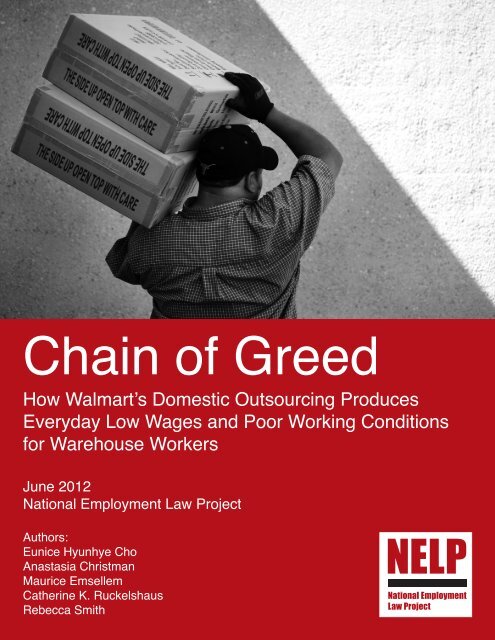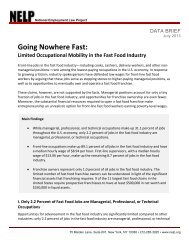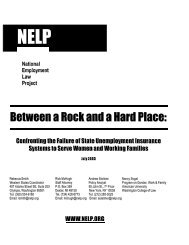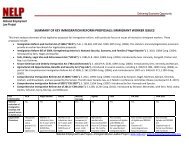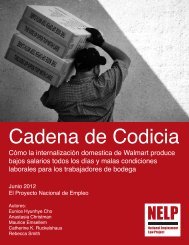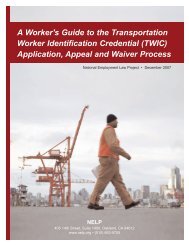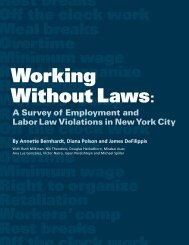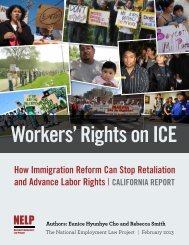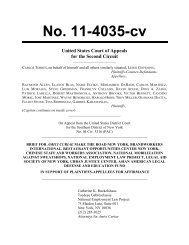Chain of Greed
Chain of Greed
Chain of Greed
- No tags were found...
You also want an ePaper? Increase the reach of your titles
YUMPU automatically turns print PDFs into web optimized ePapers that Google loves.
<strong>Chain</strong> <strong>of</strong> <strong>Greed</strong>How Walmart’s Domestic Outsourcing ProducesEveryday Low Wages and Poor Working Conditionsfor Warehouse WorkersJune 2012National Employment Law ProjectAuthors:Eunice Hyunhye ChoAnastasia ChristmanMaurice EmsellemCatherine K. RuckelshausRebecca Smith
About theNational EmploymentLaw ProjectNELP is a national non-pr<strong>of</strong>itorganization that engagesin research, education andadvocacy to improve economicopportunities and strengtheneconomic security for workingfamilies.AcknowledgementsThe authors are indebted to several organizations and individuals who helped make this reportpossible. We thank the Warehouse Worker Resource Center, a non-pr<strong>of</strong>it organization that provideslegal help and other key services to the warehouse workers employed in Southern California. Weare also grateful to several individuals associated with Warehouse Workers United, a project <strong>of</strong> theChange to Win Strategic Organizing Center, especially including Sheheryar Kaoosji, Guadalupe Palma,Nicholas Allen, Elizabeth Brennan and Michael Long. Finally and most important, we are deeplyindebted to the many workers who have shared their stories <strong>of</strong> the daily struggles and indignitiessuffered by those employed in the warehouse industry to move Walmart products.
ContentsI. Executive Summary 02II. Domestic Outsourcing in the U.S. Economy 04III. The Walmart Regime Squeezes Its Suppliers and the U.S. Workforce 06IV. The Distribution Operations: Walmart’s Crown Jewel 08V. A Case Study <strong>of</strong> Outsourced Walmart Logistics:Warehouse Workers in the Inland Empire <strong>of</strong> Southern CaliforniaA. The Walmart Warehouse Contractors 11B. Holding Down Costs, Enabling Abuse: Outsourcing’s Downward Pressure 12VI. Outsourcing Imposes a Severe Toll on Latino Workers14VII. Recommendations: Strengthening Accountability for Working Conditions 18Endnotes 22© National Employment Law Project
Executive SummaryFew U.S. corporations have attracted more intense scrutiny <strong>of</strong> their business and labor practices than Walmart. However,while poor working conditions and wage violations among the company’s retail employees have been documented 1 andworker rights violations attributed to Walmart’s international suppliers well publicized, 2 far less understood are thepervasive labor abuses that take place outside <strong>of</strong> Walmart’s stores but in its domestic supply chain, in service <strong>of</strong> itsbottom line here in the U.S. These worker rights violations are largely the product <strong>of</strong> Walmart’s signature and aggressivepractice <strong>of</strong> “outsourcing” elements <strong>of</strong> its warehousing, transportation, and goods-delivery systems to companies that,in turn, <strong>of</strong>ten further subcontract the work to still other entities or individuals.These outsourced workers laboring on Walmart’s behalf toil at the bottom <strong>of</strong> a complex hierarchy <strong>of</strong> intermediariesand in alternative employment schemes that leave them vulnerable to significant worker rights abuses and unsurewhere to seek redress. Walmart sets the parameters for the working conditions in these facilities, sometimes directlyby having managers onsite, and sometimes indirectly through monitoring suppliers’ operating costs and setting evermore stringent price demands. But when things go wrong, it’s the contractors that are blamed, while Walmart skirtsresponsibility for its actions and accountability for its influence over those engaged in its massive supply chain.This report seeks to shed light on this shady side <strong>of</strong> outsourcing by pr<strong>of</strong>itable corporations like Walmart, and thedevastating impact <strong>of</strong> the practice on U.S. workers. It is a case study <strong>of</strong> how domestic outsourcing, when not properlyregulated by robust laws, and when used by aggressive cost-cutting corporate giants, squeezes all the players in thesupply chain beyond their limits, ultimately inflicting severe pain on the subcontracted workforce. In the case <strong>of</strong>Walmart’s logistics systems, it is a story <strong>of</strong> low-paid and extremely dangerous warehouse work, with workers unloadingand loading boxes, up to 200-pounds, from shipping containers on a piece rate system for days and hours on end.But it is also an inspiring story <strong>of</strong> a diverse and talented workforce that is bravely organizing and risking retaliation bytaking on Walmart and its contractors to fight for fair working conditions, and <strong>of</strong> determined state <strong>of</strong>ficials seeking toensure that the labor and employment laws are strongly enforced to level the playing field for law-abiding employers.Focusing on the warehouse workers employed in Southern California and elsewhere who move Walmart goods acrossthe U.S., this report seeks to promote a broader discussion about corporations’ decisions to contract-out dangerous,labor-intensive parts <strong>of</strong> their businesses to the lowest bidder, and the ill effects this can have on workers, their families,and communities.As described below, greater transparency and accountability within these multi-layered hydra-like logistics chains areurgently needed. At a time when U.S. economic growth skews so heavily toward low-wage industries and jobs, it iscrucial that the public and policymakers alike better understand and respond to the practices and strategies that arepropelling this lopsided change. We hope that this report and the case study it highlights will contribute to this broaderunderstanding.Of special significance, the report details the following findings and conclusions:Domestic outsourcing is on the rise across key U.S. industries: Contracting out is becoming increasinglycommon in many <strong>of</strong> the nation’s largest and fastest-growing industries, including construction, day labor, janitorialand building services, home health care, warehousing and retail, agriculture, poultry and meat processing, high-tech,delivery, trucking, home-based work, and the public sectors. Even hotels have begun to outsource traditional functions,including cleaning services. Often relying on the use <strong>of</strong> temporary and staffing agencies, outsourcing in these industrieshas also resulted in comparatively lower wages for work similar to the jobs previously performed in-house.02
Walmart squeezes supply-chain contractors and U.S. workers: Walmart’s policy <strong>of</strong> enforcing ever-lowerprices has serious implications for the working conditions throughout Walmart’s supply chain. Even manufacturingbehemoths are not immune from the pressures Walmart can impose on their pr<strong>of</strong>it margins, and by extension,their employment practices. Walmart’s stated “Plus One” bargaining strategy, which requires that all suppliers andcontractors reduce their price <strong>of</strong> goods, increase quality or increase speed <strong>of</strong> delivery every year, vividly exemplifies thepressure that squeezes contractors’ margins and encourages low-road employment behavior like cutting corners onsafety and violating wage and hour laws.Walmart’s outsourced logistics operations raise critical labor concerns: As Walmart’s leadership onceexplained to Wall Street analysts, “The misconception is that we’re in the retail business, we’re in the distributionbusiness.” 3 While Walmart maintains a vast and sophisticated distribution system operated in-house, it also relies onsome <strong>of</strong> the nation’s largest third-party providers to ship and store its goods, including Schneider National and SwiftTransportation, which in turn contract with a complex web <strong>of</strong> temporary agencies to supply the warehouse workforce.In major logistics hubs around the U.S., from Southern California to Chicago to New Jersey, workers employed byoutsourced Walmart logistics operations have raised allegations <strong>of</strong> unpaid wages, health and safety and other seriouslabor violations.Labor violations are rampant in Southern California’s Inland Empire, which is a warehouse nervecenter for Walmart goods. Under the watchful eye <strong>of</strong> Walmart managers, the outsourced warehouse operations<strong>of</strong> Schneider Logistics and its temporary staffing firms (Rogers Premier and Impact Logistics) have produced rampantwage and overtime and health and safety violations that are the subject <strong>of</strong> a class action lawsuit. Indeed, evidenceproduced as a result <strong>of</strong> the lawsuit makes clear that Walmart is intimately involved in the daily operations <strong>of</strong> theSchneider operations, which solely move Walmart goods. This report, court documents and recent investigations bythe California Labor Commissioner and the California Division <strong>of</strong> Occupational Safety and Health (Cal/OSHA) revealthe breadth <strong>of</strong> labor abuses taking place in these warehouses. They include confusing “piece rate” pay schemes whereworkers are only paid for unloading and loading containers, not for other work performed, for working lengthy hourswith no overtime pay, for illegal and falsified pay records, and for hazardous workplace conditions (especially excessiveheat, pressure for speed, and unstable storage stacking). These conditions have also created a climate <strong>of</strong> fear amonga largely Latino workforce that claimed labor violations and were subsequently threatened with termination, and afederal court ruling vindicating the workers who alleged retaliation.Domestic outsourcing imposes an especially severe toll on Latino workers in Southern Californiaand around the U.S.: Latinos <strong>of</strong>ten represent a large segment <strong>of</strong> those industries where domestic outsourcing bymajor corporations is most prevalent. In addition, the same industries that implement contracting-out and employvulnerable, <strong>of</strong>ten Latino, workers frequently also have the highest rates <strong>of</strong> workplace violations <strong>of</strong> core labor standards.A 2009 study <strong>of</strong> over 1800 low-wage workers in Los Angeles – nearly 1300 <strong>of</strong> them Latino – found that minimumwage violations affected 38.3 percent <strong>of</strong> the workers, and that an astounding 79.6 percent <strong>of</strong> Latino workers hadsuffered violation <strong>of</strong> their overtime pay rights in the week prior to the survey. Logistics companies are no exception. Inthe production, packaging and warehousing occupations reported in the Los Angeles survey, overtime violation ratesreached 37.3 percent <strong>of</strong> workers, with meal break violations affecting 83.4 percent <strong>of</strong> these workers.We should hold major corporations accountable for worker rights abuses that result fromunfettered domestic outsourcing. The challenge for policy makers and enforcement agencies is to use existingenforcement tools effectively to protect workers’ interests, while developing new models to hold these corporateentities accountable for the conditions they engender within the production and logistics pyramids they command.The report <strong>of</strong>fers a combination <strong>of</strong> strategies that go a long way to: (1) enforce existing labor standards laws that holdmultiple entities jointly responsible for any work performed in the business; (2) promote innovative state and federallaws and enforcement strategies to target contracting abuses; (3) secure agreement from Walmart and other supplychain controllers to adopt strong codes <strong>of</strong> conduct; and (4) document the scope <strong>of</strong> contracting-out and its impact onU.S. workers.03
Domestic Outsourcingin the U.S. EconomyAmong the myriad challenges toimproving outsourced workers’ jobs,the difficulty <strong>of</strong> even identifyinghow many workers labor under theseemployment models looms large.Earlier government-commissionedstudies during more robust economicperiods concluded that as much as 30percent <strong>of</strong> the workforce was in somesort <strong>of</strong> “contingent,” or non-standard,employment relationship. 4 Someestimate that in the future, as muchas 50 percent <strong>of</strong> the new jobs createdwill be nonstandard ones, and willcomprise more than one-third <strong>of</strong> theworkforce. 5The terminology used to characterizealternative work arrangements varieswidely: “precarious,” “nonstandard,”“flexible,” “market-mediated,”“contingent,” and “vulnerable” areall terms that researchers have usedto describe this population, andtheir categories may include not justcontracted workers but also temporaryworkers, employees misclassifiedas independent contractors, parttimeworkers and even all low-wageworkers. 6 These imprecise definitionsare both a result and a cause <strong>of</strong> adearth <strong>of</strong> <strong>of</strong>ficial data on these workarrangements.Although there are numerous governmentsurveys on occupations and industries,there is no precise measure<strong>of</strong> the number <strong>of</strong> workers in the UnitedStates who are contracted out, andcalculating that number with any degree<strong>of</strong> certainty poses huge difficul-04
ties. We do know that contracting outis becoming increasingly common inmany <strong>of</strong> our largest—and some <strong>of</strong> ourfastest-growing—industries, includingconstruction, 7 day labor, 8 janitorialand building services 9 , homehealth care, 10 warehousing and retail,11 agriculture, 12 poultry and meatprocessing, 13 high-tech, 14 delivery, 15trucking, 16 home-based work, 17 andthe public sectors. 18 Even hotels haverecently outsourced traditional functions,including cleaning services. 19Despite the challenge <strong>of</strong>ficial dataposes to ascribing the nature <strong>of</strong>employment relationships to workers,we can begin to discern the quality<strong>of</strong> these jobs by looking at one type<strong>of</strong> domestic outsourcing in whichresearchers have been able to isolatedata: the employment servicesindustry, which includes temporaryagencies. In recent decades, employershave moved away from the traditionaluse <strong>of</strong> temporary firms for clerical andadministrative work and increasinglyrelied on temporary staffing agenciesfor a wider range <strong>of</strong> jobs; assembly,packing, manufacturing, buildingservices, and food services are only afew <strong>of</strong> the kinds <strong>of</strong> work performedby temp agency employees. Many <strong>of</strong>these outsourced jobs come with asignificant wage penalty. For example,in 2004, construction workersemployed by temporary agenciesmade 49.5 percent less than theirin-house counterparts, temporaryassemblers and fabricators made 49.2percent less, and all other productionworkers supplied by temp agenciessuffered a 39.4 percent wage penalty. 20As the economy struggles to recoverfrom the Great Recession, temporaryagencies are growing significantly.During the third quarter <strong>of</strong> 2010,the staffing industry estimated 2.6million workers a day worked astemps. 21 Preliminary data from theBureau <strong>of</strong> Labor Statistics (BLS) forApril 2012 shows almost 2.5 millionpeople working as temps, a 13 percentincrease over their figures for 2010. 22While these temporary employmentfigures cover only a small portion<strong>of</strong> contracted-out workers in oureconomy, they <strong>of</strong>fer a glimpse <strong>of</strong>why it is so critical to gain a betterunderstanding <strong>of</strong> these nonstandardemployment arrangements andaddress the challenges to holdingcorporations all along the contractingchain responsible for adhering to laborlaws and upholding worker standards.05
The Walmart Regime Squeezes ItsSuppliers and the U.S. WorkforceWalmart has long been reputed topay its direct employees poverty wages.A 2011 study found that Walmartemployees earn approximately 12percent less than retail workers overall,and more than 14 percent lessthan workers in other large retail establishments.23 In numerous states,Walmart tops the list <strong>of</strong> companieswith employees on public assistance,even after the company rolled out itsmuch-publicized (if largely unaffordable)health care plan. 24Walmart’s model <strong>of</strong> consistent lowprices and rigorous tracking <strong>of</strong> salesdata enable the retail giant to avoidwhat one Walmart CEO called the“peaks and valleys in volumes thatdrive labor costs through the ro<strong>of</strong>.” 25Furthermore, studies show that whena new Walmart store opens, overallretail employment levels—includingthe new Walmart jobs—in the surroundingarea decrease; according tothese researchers, Walmart expansionsexercise a kind <strong>of</strong> reverse rippleeffect on the local economy. 26These practices force competitors toscramble to match Walmart’s laborcosts. By 2005, Walmart’s move intothe grocery business had increased toa 20 percent market share nationally,27 compelling competitors to pushback against long-standing wagefloors for their own employees. 28<strong>Chain</strong>s like Albertson’s, Kroger, andSafeway have abandoned some markets,29 and in others have themselvesadopted low-price strategies triggeringmassive strikes by unionized groceryworkers seeking to protect theirworkplace standards. A five-monthstrike by tens <strong>of</strong> thousands <strong>of</strong> Californiagrocery workers in 2004 resultedin a two-tiered wage system and theloss <strong>of</strong> some health care benefits. 30“Walmart has sufficientmarket share to set theoverall terms <strong>of</strong> economicrelationships throughoutits supply chain.”Walmart has also faced charges <strong>of</strong> liabilityfor worker safety hazards relatedto its construction contractors. 31A lawsuit was recently filed againstWalmart in Massachusetts on behalf<strong>of</strong> a worker who was electrocuted todeath while performing demolitionwork at a Walmart store. The suit allegesthat the Walmart contractorhired unlicensed electrical firms andthat similar charges were broughtagainst the same contractor in Louisiana.Another Walmart contractorwas sanctioned in Indiana as a result<strong>of</strong> a massive explosion on Walmartpremises that killed another workerand injured two others. 32Walmart’s policy <strong>of</strong> enforcing everlowerprices implicates wages andworking conditions throughoutWalmart’s supply chain as well. Waltonfamily heir and Walmart chairRob Walton once wrote, “The manufacturer’sprice is something that’sdetermined largely by the negotiatingpower <strong>of</strong> the retailers that carryhis merchandise.” 33 And Walmart hasa great deal <strong>of</strong> that negotiating power.Whereas observers <strong>of</strong> the marketonce worried that an over-large manufacturercould boost its own pr<strong>of</strong>itsby squeezing retailers, the oppositecaution now prevails.While Walmart does not technicallyhold a monopsony—it is not theonly buyer in the market—it has sufficientmarket share to set the overallterms <strong>of</strong> economic relationshipsthroughout its supply chain. 34 AsWalmart and its big-box retail peershave grown, they have achieved a level<strong>of</strong> dominance that affects – indeed,sometimes dictates—their suppliers’own pricing, pr<strong>of</strong>it margins, and operationaldecisions. Even manufacturingbehemoths are not immuneto the pressures Walmart can imposeon their pr<strong>of</strong>it margins, and by extension,their employment practices.Walmart’s stated “Plus One” bargainingstrategy, which requires that allsuppliers and contractors reducetheir price <strong>of</strong> goods, increase qualityor increase speed <strong>of</strong> delivery everyyear, vividly exemplifies the pressurethat squeezes contractors’ marginsand incents low-road employmentbehavior like cutting corners on06
safety and violating wage and hourlaws. 35Even casual followers <strong>of</strong> the businesspages can recall stories likethat <strong>of</strong> Carolina Mills, a North Carolinacompany that had to shut downmore than half its mills and lay <strong>of</strong>fthousands <strong>of</strong> workers to competefor Walmart business. Perhaps themost famous example <strong>of</strong> the businesscost <strong>of</strong> supplying to Walmartis the story <strong>of</strong> Vlasic pickles. OnceWalmart insisted upon selling onlygallon-sized jars <strong>of</strong> uncut pickles atits stores, Vlasic began to lose saleson its more pr<strong>of</strong>itable processed foodproducts. Walmart came to accountfor 30 percent <strong>of</strong> Vlasic’s business,but the producer’s pr<strong>of</strong>its dropped by25 percent. 36 Finally, Vlasic had to filefor bankruptcy.Other companies struggle to stayafloat as Walmart engages in businesspractices that lower its own bottomline, but don’t fit into standardsupplier-retailer relationships. In itsfinal year <strong>of</strong> business, shoe makerBig Smith Brands revealed to investorsthat Walmart took between 15and 25 days longer to pay for merchandisethan did other customers. 37Some lawyers also note that provisionsin the company’s boilerplatevendor agreement make suppliersliable for chargebacks if a productdoesn’t move <strong>of</strong>f Walmart’s shelves. 38According to one report, Walmart demandsspecialized products from itssuppliers, including unique packagingand computer tracking systems,and the company may demand toexamine suppliers’ financial recordsand insist on cutting margins the retailgiant perceives to be too high. 39All these demands put pressure onsuppliers to eat away at their ownoperating costs, and encourage themto emulate Walmart’s low-qualityworker standards to meet an everdiminishingbottom line. Indeed, forlabor-intensive industries like warehousing,cutting costs at workers’expense may seem the only viablemeans to meet the demands drivenfrom the top down.07
2018 Business ProposalThe Distribution Operations:Walmart’s Crown JewelIt comes as little surprise that a company that dominatesthe retail landscape would also dominate the business <strong>of</strong>moving goods from one location to another. Logistics haslong been a focus <strong>of</strong> Walmart management; as companyleadership once explained to Wall Street analysts, “Themisconception is that we’re in the retail business, we’re inthe distribution business.” 40 Walmart’s early focus on rurallocations meant challenges for getting goods to stores,and the company’s first public <strong>of</strong>fering was to financedevelopment <strong>of</strong> a private distribution system. 41 The companyships approximately 80 percent <strong>of</strong> its merchandisethrough 133 distribution centers, 105 <strong>of</strong> which it ownsand operates, one it owns but operates through anotherentity, and 27 that are owned and operated by other companies.42“The misconception is that we’re in theretail business, we’re in the distributionbusiness.”Many <strong>of</strong> these third-party providers are themselves enormouscompanies with tens <strong>of</strong> thousands <strong>of</strong> employees,but questionable employment practices. Among them isSchneider National, with 210 facilities world-wide totaling10 million square feet, revenues <strong>of</strong> $3.7 billion, andmore than 18,000 employees supplemented by nearly2,000 so-called “independent contractor” drivers. 43 Driversand mechanics employed by Schneider have filedsuits alleging illegally withheld wages, failure to providemandated meal and rest breaks, and withholding accruedvacation pay upon termination. 44 Schneider alsooperates several distribution centers handling Walmart’sgoods across the country, including one in Mira Loma,California, which is solely dedicated to moving Walmartmerchandise. 45 Workers in multiple Schneider-operatedwarehouses fulfilling Walmart orders have described asystem where a piece-rate calling for pay per trailer led toconstant speed-ups in the work, where bathroom breakswere insufficient, and never-ending physical labor resultedin lasting injuries. 46Nine other Walmart centers located throughout theSoutheast are managed by Swift Transportation. 47 Swift,which has been the subject <strong>of</strong> lawsuits alleging unfair paypractices, 48 was also recently compelled to pay a $4 millionsettlement to the Port <strong>of</strong> Los Angeles for failing to live upto the requirements <strong>of</strong> the Port’s Clean Trucks Program. 49Analysis <strong>of</strong> the government’s 2005 Contingent Work Survey(CWS) indicates that <strong>of</strong> those who self-reported workingas temporary helpers, laborers and hand materialmovers, one third were assigned to trade/transportationclients. 50 These workers perform an enormous amount <strong>of</strong>physical labor very quickly, and the centers function nonstop.One third-party warehouse manager, ASW Global,estimates that in its two Walmart facilities, workers movenearly 1,000 truckloads a week, shifting 22,000 palletsout <strong>of</strong> the warehouses at “a high velocity.” 51In its annual “Global Responsibility Report,” Walmart’sPresident and CEO Michael Duke promises, “[W]e arestrengthening our commitment to transparency andholding ourselves accountable for what we do within ourcompany and for our communities.” 52 In choosing unscrupulouscontractors to perform such a core part <strong>of</strong> itsbusiness, Walmart is belying those promises by pretendingit has no role in determining the conditions underwhich they work.Just as Walmart’s employment practices toward its directemployees undercut fairer working conditions in otherretail outlets, its logistics model has shaped the entireindustry, compelling shippers to adopt strategies to constantlycut prices as Walmart competitors demand thesame efficiencies the retail giant enjoys. Indeed, its grocerycarriers confirm that they operate equipment specificallydesigned to Walmart’s specifications; according toindustry sources this fleet may be as large as 5,000 refrigeratedtrailers. 53 At the same time, Walmart increasinglydemands its shippers do tasks that were once considereda retailer’s responsibility, including placing price stickerson goods or packaging them so that they can go directlyonto the salesroom floor. 54 Outsourcing and other contingentwork models like “permatemping” have becomeincreasingly standard in the industry. Just as Walmartcontracts with companies like Schneider and Swift, 55other companies too are turning to third-party logistics08
2018 Business ProposalJesus Sauceda works at Schneider Logistics,unloading Walmart products, so his two boys willhave a better life. He says it is the hardest job hehas ever had, and he has serious concerns about hishealth and safety. The products he unloads from thesteel shipping containers from China are paddedwith fiberglass. “When you are in the container, dustand fiberglass used to wrap the boxes flies all overand you inhale it. It gets in your eyes and you knowit’s bad for you.” When Jesus told his supervisorabout his concerns, the response was “that’s how thework is. If you don’t like it, go do something else.”For more than six years, Jose Garza has worked a double shift, 362 days a year, moving Walmart goods for ImpactLogistics at Schneider’s Mira Loma warehouse. His standard work day has been 16 hours with no overtime, no timefor lunch and no breaks except to go to the bathroom. For years, Jose was paid piece rate, which meant he was paidby the number <strong>of</strong> containers he unloaded. Whether it took two hours or eight hours, he was paid the same amount percontainer, meaning his pay <strong>of</strong>ten dipped below the minimum wage and he was not paid overtime. If he split the workwith a co-worker, they split the money. Jose and his co-workers spent long, hard hours working in these warehouses,and struggled under the unfair piece rate scheme to make enough money to survive.providers (known as 3PLs).According to industry reports, a typical shipping customerspends 12 percent <strong>of</strong> sales revenues on logistics, and <strong>of</strong>these funds, 42 percent are spent on outsourcing. 56 While3PLs market their services as a tool for smaller businessesto start up their own supply chain operations, they alsorelieve the client company from hiring or training employees,and corporations have responded enthusiastically tothe shedding <strong>of</strong> these functions and the accompanyingresponsibility for labor standards. 57 The 3PLs typicallyprovide warehouse space and workers throughout thecountry and provide services that the client categorizes astransactional, operational and repetitive. 58operators—to embrace a philosophy that puts low pricesabove all else and deemphasizes worker standards,Walmart and its peers have managed to induce thesecompanies to organize their businesses in the retailers’image. When a major customer is constantly demandingever tighter margins and greater efficiencies, and reducescompensation when worker productivity declines, suppliersmay feel they have little choice but to replicate lowwage,largely part-time, highly contingent employmentpractices.By pushing all the actors along the supply chain—frommanufacturers, to shipping companies and warehouse09
A Case Study<strong>of</strong> OutsourcedLogistics:WarehouseWorkers in theInland Empire<strong>of</strong> SouthernCalifornia10
The WalmartWarehouseContractorsSouthern California’s Inland Empireregion, just east <strong>of</strong> Los Angeles, ishome to the nation’s largest distributionhub for sellers <strong>of</strong> consumergoods, including giant retailers likeWalmart. Enormous warehouses,some as large as one and a half millionsquare feet, line the region’s dustyroadways.The Inland Empire region is one thefastest growing regions in California,and is projected to grow from 3.9 millionpeople in 2005 to 4.9 million by2015. Latino and Asian communitiescontribute largely to this explosivegrowth, and Latinos will constitutea majority <strong>of</strong> the Inland Empire by2015. 59 Families in the Inland Empirehave faced significant challengesin the downturn. The unemploymentrate in the region is one <strong>of</strong> the highestin the country at 10.1 percent, andthe region has the third highest percentage<strong>of</strong> housing units in foreclosureamong large metropolitan areas.60 The economic insecurity <strong>of</strong> thesefamilies, however, is compounded bythe warehouse industry’s low-wagemodel.Workers at these warehouses are atthe nerve center <strong>of</strong> U.S. commerce:they transfer imported goods frominternational and domestic shippingcontainers into vast warehouses,and reload trucks with tons <strong>of</strong> merchandisefor shipment to retail storesaround the country. With unemploymentin the region high, these warehousejobs are critical to the community.61 But the grim reality is thatthe vast majority <strong>of</strong> warehouse jobsare now low-wage positions with fewworker protections. Certain commonfeatures prevail for workers at thesedistribution centers: first, wages arelow; second, labor violations are rampant;and third, pay practices are <strong>of</strong>tenfraudulent.At the Schneider Logistics distributioncenter in Mira Loma, California,one <strong>of</strong> the largest Walmart warehousingfacilities in the nation, workersunload trailer trucks filled with boxesand other cargo headed for Walmartregional distribution centers aroundthe country. To cut costs, Walmartcontracts with outfits like Schneiderto handle its shipping and logisticsneeds. A self-described “premier provider<strong>of</strong> transportation, logistics, andintermodal services,” Schneider wonWalmart’s 2011 General MerchandiseDiamond Carrier <strong>of</strong> the Year. 62Schneider cuts its own costs by contractingwith temporary staffing firmsto meet its labor needs at even lowerrates. The result? Thousands <strong>of</strong> workersperforming backbreaking anddangerous work for long hours, at lowwages, under conditions that violatethe workers’ most fundamental laborlaw rights.Despite contracting with outfits likeSchneider, Walmart maintains tightcontrol over day-to-day operationsin its warehouses. As recent court filingsindicate, Walmart sets productivitystandards for warehouse workers,and when worker productivity has declined,Walmart has cut compensationto Schneider. Walmart also imposesnumerous conditions on Schneiderabout the qualifications that warehouseworkers must meet before beinghired. Tax records also show that11Walmart owns one <strong>of</strong> the warehousesat the facility, and has part ownershipshare in another. 63 The plaintiffs arepetitioning the court to compel Schneiderto produce additional informationon Walmart’s role with regard tothe Schneider warehouse operationsin order to determine whether the retaileris also liable for California laborlaw violations.The Schneider Logistics center in theInland Empire is not unique. Warehouseworkers in other key Walmartdistribution hubs report identicalstructures <strong>of</strong> labor subcontractingand temporary staffing, as well asrampant labor violations. In otherhub areas such as Chicago, Illinois,and New Jersey, companies handlingWalmart logistics—including Schneider—similarlysubcontract withtemporary staffing companies to hireworkers. 64 Not surprisingly, workershave encountered equally bad laborconditions.Workers at Walmart warehouses inthe Chicago area have faced unpaidwages, confusing piece-rate pay scales,incorrect pay stubs, failure to payovertime, and violations <strong>of</strong> labor lawinvolving many <strong>of</strong> the same corporateplayers. 65 A recent study reported thatthe majority <strong>of</strong> Chicago-area warehouseworkers earned wages belowthe federal poverty line. Althoughworkers hired by temporary agenciesperformed the same work as thosedirectly hired, temp workers’ paywas roughly $3 less per hour on average.66 Workers also reported paymentsystems based on a confusing “piecerate” paid for every truck loaded orunloaded, resulting in pay violations,and poorly recorded timesheets. 67 Astudy <strong>of</strong> New Jersey warehouse workerssimilarly revealed that warehouseworkers at Walmart-affiliated facilitiesearn lower wages than their peers.At least a third <strong>of</strong> warehouse workerssurveyed had experienced wage theft
(i.e., the denial <strong>of</strong> wages they hadearned), and more than one in tenhad been injured while working in adistribution facility. 68A study <strong>of</strong> warehouse work in theInland Empire found that the concentration<strong>of</strong> logistics facilities therehad nurtured a fast-growing industry<strong>of</strong> warehouse temporary agencies. In1990 there were 119 such agencies inthe Inland Empire, but by 2008, thenumber had grown to 424 establishments.As a result, the region has ahigher concentration <strong>of</strong> temporaryemployment than any other in thestate. 68Holding DownCosts, EnablingAbuse:Outsourcing’sDownwardPressureIn some cases, subcontracted logisticsworkers themselves are able to see adirect causal relationship betweenWalmart’s ceaseless demands forlower prices and their working conditions.Workers at the Mira Loma SchneiderLogistics distribution center have nodifficulty establishing a direct connectionto Walmart. As recent courtdocuments filed by plaintiffs specify,the only goods loaded and unloadedat the facility are those destined forWalmart stores. Walmart securityguards maintain a constant presenceat the warehouses. Walmart staff frequentlycommunicate directly withRogers-Premier and Impact Logisticsemployees, providing instructionson staffing levels, productivity,and worker misconduct. Contractsbetween Schneider and its subcontractors,Rogers-Premier and ImpactLogistics require that workers receiveorientation materials that complywith Walmart policies. Walmart haseven created a multiple choice testfor Rogers-Premier and Impact Logisticsto administer in order to ensurethat warehouse workers are properlytrained. And when worker productivityhas declined at the warehouse operations,Walmart has cut compensationto Schneider. 70Workers at Schneider Logistics havereported extensive workplace abusesresulting from cost-cutting. In October2011, warehouse workers at theMira Loma Schneider Logistics distributioncenter filed suit in federal courtto protest their working conditions. 71Workers sued Schneider Logistics, aswell as Rogers-Premier and ImpactLogistics, two temporary staffingagencies Schneider subcontracts withto supply workers, alleging violations<strong>of</strong> basic labor protections.Court documents from the case, aswell as recent investigations by theCalifornia Labor Commissioner andthe California Division <strong>of</strong> OccupationalSafety and Health (Cal/OSHA),reveal the breadth <strong>of</strong> labor abuses takingplace in these warehouses.Illegal Pay System. In February2010, Schneider Logistics and temporarystaffing agencies at the MiraLoma Logistics distribution centerinstituted a new “piece rate” system.Under this “piece rate” system, workersreceived pay only for shipping containersor trailers that were completelyfilled or unloaded by the end <strong>of</strong> ashift, resulting in rampant minimumwage and overtime violations. Workersreceived no pay at all for otherwork performed, including sweepingfloors, stacking and breaking down12pallets, unloading partial or overloadedtruck containers, filling orders,attending meetings, or waiting for anassignment at the warehouse, in violation<strong>of</strong> California law.As court documents note, the subcontractingsystem made it virtuallyimpossible for temporary staffingcompanies like Rogers-Premierand Impact Logistics to pay workerslegally-required wages for work performed.Wage statements revealedthat Schneider paid temporary staffingcompanies approximately $150for every fully loaded trailer. Afterdeducting 30% <strong>of</strong> the fee for its ownuse, only 70%, or about $105 was leftto pay workers their wages. Loadinga trailer requires at least two workersfor at least 4.5 to 7 hours per truck,leaving little money left over to payfor other work performed or for legallymandated overtime pay.Lengthy Hours, No Overtime Pay.Since at least February 2010, whenSchneider Logistics implemented thepiece rate system, warehouse workershave endured lengthy hours forweeks upon end without overtimepay. Workers reported that they <strong>of</strong>tenworked shifts up to 12 hours duringa day. One individual reported havingworked for 28 days, each with morethan eight hours a day, and sometimesmore than 16 hours per day, without asingle day <strong>of</strong>f.Illegal and Falsified Records. BeforeWalmart contractors institutedthe “piece rate” system, workers hadused a punch clock to log into workand had been paid on an hourly rate.However, after temporary staffingagencies Rogers-Premier and ImpactLogistics instituted the new piece ratepay system, warehouse workers wererequired to sign in on a blank form,and instructed not to enter other information,such as start or end time,or any break time on the form. AsEverardo Carillo, a warehouse work-
er, noted, “We were directed simplyto sign our names each morning onblank forms maintained by the supervisors.We did not write in the timewe arrived at work or the time we finished.The Rogers Premier supervisorsor the lead workers would after writedown the fake start and end times.”Lead worker Evaristo Morales reported,“I was told to write down fewerhours than any <strong>of</strong> us actually worked,and was never told to record my actualwork hours or to accurately record thework hours <strong>of</strong> any <strong>of</strong> the warehouseworkers.”In late 2011, the California LaborCommissioner issued citations totalingmore than $600,000 to Premierand almost $500,000 to Impact Logisticsfor wage and hour violations discoveredduring an inspection <strong>of</strong> theSchneider Logistics plant. Violationsincluded employers’ failure to furnishaccurate statements with paychecksthat include detail on total hoursworked, hourly pay, piece rates if suchpay is utilized, deductions, and otherwage information. 72Hazardous Workplace Conditions.Warehouse work poses several dangersto workers’ health and safety.In 2012, excessive heat, pressure forspeed, unstable storage stacking, andunguarded machinery led Cal/OSHAto issue over $250,000 in citationsfor safety hazards to warehouses, includingNFI, another Walmart contractor.73 The complexity <strong>of</strong> work performedin warehouses, fast-movingvehicles, and the pace <strong>of</strong> productionhas led Cal/OSHA to identify thewarehouse industry as one <strong>of</strong> thestate’s high hazard industries. 74 A recentacademic survey <strong>of</strong> warehouseworkers in the Inland Empire revealedthat at least 63 percent had been injuredon the job, 83 percent sufferedfrom a job-related illness, and 84 percenthad witnessed an injury to a coworker.75Climate <strong>of</strong> Fear and Retaliation.Managers retaliated against workerswho asked for more informationabout unpaid wages or about the piecerate system by denying them work, issuingdisciplinary warnings or threats,sending complaining workers home,or threatening to terminate workers.Armando Esquivel, a warehouse worker,remembered asking his supervisorabout an incorrect paycheck. “Healways promised to look into it butmy pay was never corrected, not evenonce. When I would repeat my complaints,he would tell me: ‘I have a pile<strong>of</strong> job applications on my desk morethan a foot high, if you don’t like thisjob, you can go home.’”After workers filed a lawsuit allegingviolations <strong>of</strong> labor protections,managers called a mandatory meetingin the warehouse. Two employeespresent at that meeting recalled thattheir manager crumpled up flyers discussingthe lawsuit and threatenedto “destroy you and throw you in thetrash if you get involved” in the lawsuit.76Workers alleging unlawful labor practicesat the Mira Loma warehouse facilitywere vindicated when a federaldistrict court ordered that temporarystaffing agencies Rogers-Premier andPercentage <strong>of</strong> warehouse workers injuredon the job:Percentage <strong>of</strong> warehouse workers who havesuffered from a job-related illness:Percentage <strong>of</strong> warehouse workers who havewitnessed an injury to a coworker:Impact, and the workers’ joint employer Schneider, must immediatelybegin to provide the workers withcorrect wage statements, disclose payrates for each truck container loadedor unloaded, and abide by federal andstate recordkeeping requirements. 77Instead <strong>of</strong> bringing their illegal practicesinto compliance with the law,Rogers-Premier and Schneider respondedto the workers’ lawsuit andcooperation with state labor <strong>of</strong>ficialsby announcing that their jointly employedworkers would all be terminatedwithin three months. The workersreturned to court, and celebrated amajor victory when the federal judgeprohibited the companies from terminatingthose workers. 78The Inland Empire warehouse workershave also been organizing arounda broad banner calling for fair wagesand benefits, safe working conditions,and responsible contractingpractices by Walmart. The campaign,formed as Warehouse Workers United(www.warehouseworkersunited.org),which is affiliated with the Changeto Win Strategic Organizing Centercomprised <strong>of</strong> four international unions,has been organizing in SouthernCalifornia, in the state’s capitol,and around the U.S. to champion thecause <strong>of</strong> these struggling workers.63%83%84%Deogracia Cornelio et al., Shattered Dreams and Broken Bodies: A Brief Review <strong>of</strong> the Inland Empire Warehouse Industry (LosAngeles: Warehouse Workers Accountability Commission, 2011).13
2018 Business ProposalOutsourcing Imposesa Severe Toll onLatino WorkersLast title hereLatino workers are overrepresented among contingent workers. The 2005CWS conducted by the BLS found that nearly 21 percent <strong>of</strong> contingentworkers, some 2.5 million workers, were Latino. 79 Researchers analyzingCWS data found that first and second generation Mexican-originworkers were concentrated in non-standard jobs, including temporaryand contract positions, and also the broader category <strong>of</strong> part-timeemployment. 80While Latino workers in the United States have the highest labor forceparticipation rate <strong>of</strong> any racial or ethnic group, 81 they are also at lowestrung <strong>of</strong> the economic ladder, with two in five Latino workers notearning enough to keep their families out <strong>of</strong> poverty. 82 These workers,particularly the immigrant generation, suffer increased vulnerability tolabor abuses and to the retaliation employed to silence those who stepforward to confront labor abuse. Over half <strong>of</strong> the Latino workforce isforeign-born. 83Traditionally, industries like construction and agriculture, with workforcescomprised disproportionately <strong>of</strong> Latino and immigrant workers,have used extensive contracting and subcontracting arrangements. 84More industries are now following these sectors in embracing contracting-outand using temporary workers. Recent government surveysreveal a large growth in staffing and temporary agency placements inblue-collar occupations, including more subcontracting in lower-skilledand lower-paying jobs like manufacturing, transportation, janitorial,and health care. 85 “Blue collar” or “light industrial” temporary agencieshave existed for decades and with the erosion <strong>of</strong> wages and conditions inU.S. manufacturing, combined with the increase in distribution servicessince the beginning <strong>of</strong> the 1990s, have been increasing in number. 8614
2018 Business ProposalIn 1990, <strong>of</strong>fice and administrative support workers accounted for 42percent <strong>of</strong> staffing services workers, with only 28 percent in blue-collaroccupations. By 2000, those numbers had switched, with 46 percent <strong>of</strong>staffing services workers in blue-collar jobs. 87The nature <strong>of</strong> temporary work has changed over these decades, as well.As one researcher looking at the logistics industry notes, businesseshave moved from a “reactive” use <strong>of</strong> temporary workers to fill the jobs<strong>of</strong> absent employees or to supplement permanent employees duringa busy period to a “systematic” use, “in which entire job clusters andindustries are staffed with agency workers indefinitely.” 88 Indeed, onestudy <strong>of</strong> temporary warehouse workers in New Jersey found that 69percent <strong>of</strong> workers surveyed reported being sent to the same worksite“every day,” with another 20 percent being sent to the same site three orfour times a week. 89Before the Great Recession, more than a million Latino workers wereemployed in transportation and materials moving. 90 Latino workersalso form a majority <strong>of</strong> the Inland Empire workforce. 91 Case studies<strong>of</strong> logistics facilities confirm the relationship between contracting,subcontracting and a high representation <strong>of</strong> Latino workers. A study<strong>of</strong> working and living conditions for Latinos in Memphis, Tennessee,found that large corporate headquarters in the region, especially Fed-Ex, were playing a central role in developing a work culture in the logisticsindustry that emphasizes corporate flexibility, contingent jobs,low wages and a largely Latino workforce. In fact, a survey <strong>of</strong> the city’stemp agencies found that 83 percent hired Latino workers and that 17have hired bilingual staff to work with these employees. Of the agenciesthat provided an estimate <strong>of</strong> the proportion <strong>of</strong> their workforces that isDavid Acosta depends on warehousework in the Inland Empireto support his wife and theirthree children. David has beena warehouse worker for almost10 years, and since 2009 he hasworked at the Schneider warehousein Mira Loma, Californiamoving merchandise destined forWalmart stores.David used to work long days, <strong>of</strong>ten16 hours with no breaks, notime for lunch and no overtimepay. In late 2011, David and hisco-workers took action to improvetheir working conditions byjoining a class action lawsuit andfighting against their employers’efforts to retaliate againstthose efforts. The result <strong>of</strong> thosestruggles? Now workers are paid$12.75 per hour with full benefits,and they’re protected fromretaliatory pay cuts or terminationby a federal court order.15
Latino, the median was 25 percent, far outpacing the size <strong>of</strong> the overallLatino population in Memphis. 92Not coincidentally, the same industries that implement contracting-outand employ vulnerable workers, many <strong>of</strong> whom are Latino, frequentlyalso have the highest rates <strong>of</strong> workplace violations <strong>of</strong> core labor standards.A 2009 study <strong>of</strong> more than 1800 low-wage workers in Los Angeles– nearly 1300 <strong>of</strong> them Latino – found that 38.3 percent <strong>of</strong> the workershad experienced minimum wage violations, and an astounding 79.6 percent<strong>of</strong> Latino workers had suffered overtime pay violations in the weekpreceding the survey. A large majority <strong>of</strong> Latino workers experiencedmeal and rest break violations as well. 93Logistics companies similarly generate high violation rates. In the production,packaging and warehousing occupations reported in the LosAngeles survey, overtime violations were experienced by 37.3 percent<strong>of</strong> workers, with meal break violations affecting 83.4 percent <strong>of</strong> theseworkers. 94 The highest work-related fatality rates are also in the construction,transport and warehousing and agricultural sectors, all sectorsin which both Latino workers and contracting-out predominate. 95For any worker, confronting workplace abuse can be a daunting proposition,since the power imbalance between individual workers and theiremployers is so great, and retaliation so commonplace. Challenges toenforcing basic labor protections are compounded for immigrant workerswho may be linguistically, culturally and <strong>of</strong>ten geographically isolated.In the context <strong>of</strong> contracted work, even workers who are aware<strong>of</strong> their workplace rights and willing to step forward <strong>of</strong>ten have littleknowledge <strong>of</strong> the identity <strong>of</strong> the responsible party or parties. Workerswill not know, for example, that the relatively undercapitalized entityone step above them on the subcontracting ladder is not necessarily theonly responsible party for labor abuses under U.S. law.For undocumented workers, irregular immigration status can meanworkplace labor violations are the order <strong>of</strong> the day, and confrontingthe abuse a near-impossible task. The 2009 survey <strong>of</strong> low-wage workersfound that <strong>of</strong> those workers who had complained about workplaceissues or attempted to form a union in the prior 12 months, 47 percenthad suffered illegal retaliation, including threats to call immigrationauthorities. 96 Indeed, the spread <strong>of</strong> nonstandard employment relationsacross industries coincides with a greater reliance on undocumentedworkers.16
When Marta Medina moved to Southern California, she got a jobin the warehouse industry at NFI Industries in Chino. Working forminimum wage through a staffing agency, she saw boxes <strong>of</strong> apparelcoming in with tags she recognized, they read “Walmart.”She also saw strict quotas and pressure to do dangerous work. “Thework here is hard. When I was pregnant and asked for lighter work,they told me ‘we didn’t hire you to have children. Work faster orleave.’”Marta began taking health and safety trainings at the WarehouseWorker Resource Center in 2010. She learned about her rights andthat her workplace was out <strong>of</strong> compliance with Cal/OSHA regulations:Boxes were stacked 12 feet and higher without restraints;forklifts and other machines were operated dangerously becausethe company did not adequately train the drivers; and the employerclosed doors on workers as the heat <strong>of</strong> the desert summer repeatedlytopped 100 degrees.In the face <strong>of</strong> this, Marta joined with her co-workers and filed a complaintwith Cal/OSHA. “We didn’t know what our rights were, butwe knew we weren’t safe and needed to make a change.” At first thecompany retaliated against vocal workers including Marta by movingher to unfamiliar assignments without training and reducing herhours. But slowly she is seeing improvements. Now the company hasstarted training workers and purchasing new equipment.17
Recommendations:Strengthening Accountabilityfor Working ConditionsAs described above, Walmart’s supply chains are characterized by intense pressures to reduce costs at all levels, leavingthe workers in the labor-intensive segments <strong>of</strong> the chains too <strong>of</strong>ten underpaid and working in dangerous and unhealthyconditions. The same dynamic at play in Walmart’s case also plagues the growing assortment <strong>of</strong> industries that nowroutinely rely on a complicated blend <strong>of</strong> contracting, subcontracting and temporary work to maximize pr<strong>of</strong>its.Corporate giants are increasingly putting more business functions out to bid, catalyzing a scrum among contractorsall seeking to submit proposals that come in just a little bit cheaper than those <strong>of</strong> their competitors. Corporationslike Walmart then continue to squeeze the winning contractor to lower prices still more or lose the work, setting intomotion a perpetual process <strong>of</strong> cutting corners. If we are, indeed, moving toward an economy where nearly half thejobs created will be subject to this ongoing downward pressure, we simply cannot perpetuate a system in which clientcompanies that ultimately wield tight-fisted control can plead hands-<strong>of</strong>f in the face <strong>of</strong> deteriorating labor standardsand increasing workplace violations.The challenge for policy makers and enforcement agencies is to use existing enforcement tools effectively to protectworkers’ interests, while developing new models to hold these corporate entities accountable for the conditions theyengender within the production and logistics pyramids they command.Meeting the challenges posed by the ongoing expansion and evolution <strong>of</strong> production and supply chains and employmentarrangements will ultimately require a policy menu broad enough to accurately identify and appropriately fix liabilityon actors throughout the supply chain that have caused or contributed to workplace violations. In the meantime,several important approaches—some based on existing law and some more novel—can be pursued to penetrate themultiple layers and, eventually, hold Walmart and other corporations accountable for the abysmal job conditions theirpractices created for contracted workers.These approaches fall into four primary categories: (1) enforce existing labor standards that hold multiple entitiesjointly responsible for any work performed in the business; (2) adopt innovative state and federal laws and enforcementstrategies to target contracting abuses; (3) secure agreement from Walmart and other supply chain controllers to adoptand follow strong codes <strong>of</strong> conduct; and (4) document the scope <strong>of</strong> contracting-out and its impact on U.S. workers.Implementing these strategies consistently and aggressively will represent important steps in addressing thedeterioration <strong>of</strong> wages and working conditions contracted workers are experiencing. But much more needs to be doneto explore new approaches to maximize the level <strong>of</strong> transparency and accountability necessary to adequately protectworkers who are on the front lines <strong>of</strong> abuses that are a byproduct, by design or effect, <strong>of</strong> contracting, subcontractingand temporary work.#1: Aggressively Enforce Existing Laws Making Multiple Entities Jointly Responsible for Labor ViolationsThe federal Fair Labor Standards Act (FLSA) and most state wage laws’ definition <strong>of</strong> employers that may be held18
esponsible for wage violations are extremely broad. Enacted with full awareness <strong>of</strong> the subcontracted employmentrelationships prevalent in industries like garment manufacturing, the FLSA was intended to reach well beyond theimmediate relationship between a worker and her first-line employer, to encompass other businesses whose right tocontrol the work was sufficient to make them “joint employers” with the worksite employer.Agencies and courts enforcing this broad language disregard employment labels and inquire, instead, into who has theright to control the work, an analysis that frequently results in holding multiple employers accountable in industrieswhere multi-layered subcontracting is the norm, such as agriculture, garment, janitorial, and construction, amongothers. Strategic and concerted enforcement <strong>of</strong> these broad definitions in the industries where the problems persist isvital. One such example is the pending class action lawsuit in California that alleges wage and other violations by boththe temporary employment agencies that placed workers at the Mira Loma warehouses along with Schneider Logistics,the owner <strong>of</strong> the warehouse and one <strong>of</strong> Walmart’s primary subcontractors. 97#2: Adopt innovative laws that create greater transparency in contracting relationships and hold thecontrolling entities accountable for the abuses <strong>of</strong> their supply chain contractors.1. Establish a presumption <strong>of</strong> employer status: Include an explicit presumption in state labor standards laws that aworker is employed by a supply chain head, or more than one employer in a particular supply chain, modeled afterexisting similar laws in construction and trucking, for example. 98 Some states, including California, New York and NewJersey, hold garment and agricultural businesses with entrenched subcontracting structures accountable for any wageand hour and other workplace violations occurring in their business. 992. Pass responsible contractor laws that apply across all industries: California Labor Code Section 2810 is designed topromote accountability at the corporate level for the labor violations <strong>of</strong> a contractor when their agreement for laboror services is insufficiently funded to ensure compliance with labor laws. The California measure covers construction,garment, farm labor, security guards, and janitorial services. 100 Pending legislation (AB 1855) would expand the lawto cover warehousing and strengthen the law in other areas as well. Illinois regulates temporary, day labor and otherintermediary agencies to curb such abuses as over-charging for transportation to work and check-cashing schemes andto promote transparency in the relationship between the corporate entity and its subcontractors. 101 Other provisionsrequire temp firms to register with the state and post a bond to cover any wage abuses suffered by workers placed by thetemp agency at a worksite employer. Measures like these could be adapted to reach supply chain heads like Walmart.3. Require screening for subcontractor labor law violations when corporations compete for public contracts: The U.S.Department <strong>of</strong> Agriculture recently issued regulations, subsequently withdrawn under pressure from the businesscommunity, that would have required bidders to certify both that they and their subcontractors are complying withlabor laws. 102 Requiring labor law compliance in federal, state and local contracting leverages public resources topromote investment in good jobs and limit subcontracting abuses.19
4. Pass “hot goods” laws that permit seizure <strong>of</strong> goods and stop-work orders in a supply chain with labor standardsviolations: Under federal law, the U.S. Department <strong>of</strong> Labor (DOL) can use its “hot goods” authority to seize goodsfrom any entity if the goods were produced in violation <strong>of</strong> the FLSA. “Hot goods” authority is a powerful tool todeter unscrupulous contractors using multiple layers <strong>of</strong> under-capitalized subcontractors and engaging in unfaircompetition. Adoption <strong>of</strong> “hot goods” authority under state laws, enforceable both by state labor agencies and througha private right <strong>of</strong> action, would add tremendous heft to efforts to regulate unscrupulous practices driven by extensivecontracting.#3: Walmart and other supply chain controllers should adopt and follow strong codes <strong>of</strong> conduct regulatingcontractors and subcontractors.Walmart and other major corporations have adopted “ethics” standards that purport to regulate their contractorsand suppliers <strong>of</strong> goods and services. 103 Given the vast gaps between the goals <strong>of</strong> these policies and their enforcement,Walmart should adopt and follow a Responsible Contractor Policy, as proposed by Warehouse Workers United (theworkers employed in the Inland Empire), that will specifically address abuses in the distribution warehouses it usesand promote quality jobs, with benefits and career ladders, regardless <strong>of</strong> the entity that nominally employs the workersonsite. 104A Responsible Contractor Policy would serve as a mechanism to ensure that the commitments Walmart has already madepublicly do, in fact, hold its suppliers and contractors to a series <strong>of</strong> standards, including respect for all laws, sustainablewages, and guarantee <strong>of</strong> freedom <strong>of</strong> association. A meaningful policy would include transparent mechanisms forindependent auditing and a system for dispute resolution, as well as concrete remedies for violations <strong>of</strong> the standards.Such a policy would have the additional virtue <strong>of</strong> applying to the entire supply chain, including overseas operations,where well-documented abuses continue to occur.#4: Document the Scope <strong>of</strong> Contracting-Out and Its Impact on the Labor Force and the Economy Overall:In recent years, more than half the states have commissioned studies and task forces to document the prevalence andimpact <strong>of</strong> independent contractor misclassification, a costly subterfuge that undermines economic and employmentsecurity for misclassified workers and robs the states and the federal government <strong>of</strong> billions <strong>of</strong> dollars each year. 105This research has helped to draw greater public attention to the problem and in a number <strong>of</strong> locations, built consensusfor reform <strong>of</strong> labor standards and enforcement practices. Similar inter-agency task forces could study the incidenceand impact <strong>of</strong> contracting and subcontracting in targeted industries (as independent contractor studies looked atconstruction as a starting point in some states), or across the economy.In addition, federal and state agencies that already collect employment status data should clarify their questions aboutwork locations and inter-industry domestic outsourcing to better highlight the variety <strong>of</strong> employment relationshipsbetween contracted workers, their direct employers and the clients for which they perform work. 106 The governmentsponsoredContingent Worker Survey (CWS) had its challenges due to its small sample size and dependence on workers’understanding <strong>of</strong> complicated employment structures, but it was an initial attempt to capture these changing workplacepatterns. This data collection effort stopped several years ago, leaving us with no clear sense <strong>of</strong> how the country’ssevere and prolonged economic contraction has affected these kinds <strong>of</strong> employment relationships. Nor can we trackthe number <strong>of</strong> non-standard jobs as we move through recovery, to distinguish short-term employment strategies fromlong-term restructuring. We must examine the strengths and shortcomings <strong>of</strong> the CWS to design data collection thatwill allow all stakeholders meaningful tools to study contracting, subcontracting and other non-standard employmentpractices.20
Endnotes1See, for example, Micha Peled, Store Wars: When Walmart Comes to Town, ITVS (2002), http://www.pbs.org/itvs/storewars/stores3.html. See also Shelly Banjo, “Wal-Mart to Pay $4.8 Million in Back Wages, Damages,” Wall StreetJournal, May 1, 2012. For a list <strong>of</strong> 63 wage and hour suits settled by Walmart in 2008, see its 2009 10-K financial filing.Walmart Stores, Inc., Annual Report (Form 10-K), at 7 (Jan. 31, 2009), available at: http://sec.gov/Archives/edgar/data/104169/000010416909000006/d10k.htm.2For example, in 2005, the Labor Rights Fund filed suit in state court in Louisiana alleging sub minimum wages andsome cases <strong>of</strong> physical abuse in Bangladesh, China, Indonesia, Nicaragua and Swaziland. Steven Greenhouse, “Wal-Mart Sued on Overseas Factories,” New York Times, Sept. 14, 2005, accessed May 29, 2012, http://www.nytimes.com/2005/09/14/business/worldbusiness/14iht-walmart.html. See also Martin Hearson, Cashing in: Giant Retailers,Purchasing Practices, and Working Conditions in the Garment Industry (San Francisco: Clean Clothes Campaign, 2009);Andy Kroll, “Are Walmart’s Chinese Factories as Bad as Apple’s?” Mother Jones, March/April 2012, accessed May29, 2010, http://www.motherjones.com/environment/2012/03/walmart-china-sustainability-shadow-factoriesgreenwash.There is currently an online petition campaign in support <strong>of</strong> workers in Thailand who process shrimp forWalmart. “SumOfUs Petition to Walmart: Stop Human Rights Abuses in Your Factories,” May 7, 2012, http://www.changetowin.org/news/sum<strong>of</strong>us-petition-walmart-stop-human-rights-abuses-your-factories.3Andrea Lillo, “Walmart Gains Strength from Distribution <strong>Chain</strong>,” Home Textiles Today, March 24, 2003, quoted inNelson Lichtenstein, The Retail Revolution: How Walmart Created a Brave New World <strong>of</strong> Business (New York: Picador,2009), 4.4Economic Policy Institute, The State <strong>of</strong> Working America 1998-99, (Ithaca: Cornell University Press, 1999); U.S.General Accounting Office, Contingent Workers: Income and Benefits Lag Behind Those <strong>of</strong> Rest <strong>of</strong> Workforce, GAO/HEHS-0076 (Washington, DC: General Accounting Office, 2000), http://www.gao.gov/new.items/he00076.pdf .5Eve Tahmincioglu, “Need a Job? Contract Labor Could Be New Normal,” MSNBC.com, May 6, 2010, accessed May29, 2012, http://www.msnbc.msn.com/id/36826679/ns/business-careers/t/need-job-contract-work-could-be-newnormal/#.Tt6FfbKImU8.6See, for example, Arne Kalleberg, “Nonstandard Employment Relations: Part-time, Temporary and Contract Work,”Annual Review <strong>of</strong> Sociology 26 (2000), for a literature review highlighting the range <strong>of</strong> definitions and scopes <strong>of</strong> studyin this area.7Christian Livermore, “State Fines Hospital Subcontractor in Pay Scheme,” Times Herald-Record, June 10, 2010;Francois Carre, J.W. McCormack, et al., “The Social and Economic Cost <strong>of</strong> Employee Misclassification in Construction,”(Labor and Worklife Program, Harvard Law School and Harvard School <strong>of</strong> Public Health: December 2004), 6.8Abel Valenzuela and Nik Theodore, “On the Corner: Day Labor in the United States,” (2006), accessed May 29, 2012,http://www.sscnet.ucla.edu/issr/csup/uploaded_files/Natl_DayLabor-On_the_Corner1.pdf.9See Coverall N. Am., Inc. v. Comm’r <strong>of</strong> the Div. <strong>of</strong> Unemployment Assistance, 447 Mass. 852 (2006); Vega v. ContractCleaning Maintenance, No. 03-C9130 (N.D. Ill. Oct. 18, 2004).10See Bonnette v. Cal. Health & Welfare Agency, 704 F.2d 1465 (9th Cir. 1983).11See California Labor Federation, “Confronting the Rise <strong>of</strong> Contingent Work in California,” (Jan. 2012), accessed May29, 2012, http://www.calaborfed.org/index.php/site/page/1408; Edna Bonacich and Juan De Lara, “Economic Crisisand the Logistics Industry: Financial Insecurity for Warehouse Workers in the Inland Empire,” (2009), accessed May29, 2012, http://www.warehouseworkersunited.org/fileadmin/userfiles/2009218-WarehouseWorkersPaper.pdf.12Sec’y <strong>of</strong> Labor v. Louritzen, 835 F.2d 1529 (7th Cir. 1988).13U.S. General Accounting Office, Employment Arrangements: Improved Outreach Could Help Ensure Proper WorkerClassification,GAO-06-656 (Washington, DC: General Accounting Office, 2006), 30, accessed May 29, 2012, http://www.gao.gov/new.items/d06656.pdf.14Vizcaino v. Micros<strong>of</strong>t Corp., 97 F.3d 1187 (9th Cir. 1996).15Ansoumana v. Gristedes, 255 F.Supp.2d 184 (S.D.N.Y. 2003).22
home builders controlled more than a third <strong>of</strong> the market in cities like Las Vegas, Nevada, and Houston, and closeto 50 percent in markets like Denver and Austin; segments <strong>of</strong> the transportation and logistics sectors; and “content”production in the entertainment industry. See David Weil, “Rethinking the Regulation <strong>of</strong> Vulnerable Work in the USA:A Sector-Based Approach,” Journal <strong>of</strong> Industrial Relations 51, no. 3 (2009).35Jennifer Caban, “Financial Success <strong>of</strong> Wal-Mart,” Yahoo! News, June 1, 2007, accessed May 29, 2012, http://voices.yahoo.com/financial-success-wal-mart-367756.html?cat=55 .36Charles Fishman, “The Walmart You Don’t Know,” Fast Company, December 1, 2003, accessed May 29, 2012, http://www.fastcompany.com/magazine/77/walmart.html.37Gosman, Marty and Kohlbeck, Mark J., The Effects <strong>of</strong> Wal-Mart on the Pr<strong>of</strong>itability and Investor Valuation <strong>of</strong> itsSuppliers (May 30, 2006), 7. Available at SSRN: http://ssrn.com/abstract=906606 or http://dx.doi.org/10.2139/ssrn.906606.38Emily Schmitt, “The Pr<strong>of</strong>its and Perils <strong>of</strong> Supplying to Walmart,” Bloomberg Businessweek, July 14, 2009, accessed May29, 2012, http://www.businessweek.com/smallbiz/content/jul2009/sb20090714_270767.htm.39Fishman, “The Walmart You Don’t Know.”40Andrea Lillo, “Walmart Gains Strength from Distribution <strong>Chain</strong>,” Home Textiles Today, March 24, 2003, quoted inNelson Lichtenstein, The Retail Revolution: How Walmart Created a Brave New World <strong>of</strong> Business (New York: Picador,2009), 48.41Graff, “Unequal Competition,” 57.42Walmart Stores, Inc., Annual Report (Form 10-K), at 7 (Jan. 31, 2012), available at: http://sec.gov/Archives/edgar/data/104169/000119312512134679/d270972d10k.htm. While outside the scope <strong>of</strong> this study, it is worth noting thatWalmart also uses 158 distribution centers in Argentina, Brazil, Canada, Chile, China, India, Japan, Mexico, SouthAfrica, and the United Kingdom, <strong>of</strong> which it owns and operates 39, leases and operates 68, and owns nine that areoperated by third-party companies, with the remaining 42 leased and operated by third-party companies.43Schneider National, “Schneider National Awarded Walmart’s 2011 General Merchandise Diamond Carrier <strong>of</strong> theYear,” news release, January 11, 2012; “Schneider By the Numbers,” Schneider National, accessed May 16, 2012, http://www.schneider.com/About_Schneider/SchneiderByTheNumbers/index.htm.44Jim Park, “California Suit Alleges Schneider Shorted Drivers on Wages, Mileage, Benefits,” Trucking Info, November11, 2010, accessed May 16, 2012, http://www.truckinginfo.com/news/news-detail.asp?news_id=72193; Bickley v.Schneider Nat’l Inc., 2011 WL 1344195, No. 08-5806 (N.D. Cal. Apr. 8, 2011); Patton v. Schneider Nat’l Carriers, Inc.,2009 WL 545779, No. 09-01010 (C.D. Cal. Mar. 3, 2009).45David Moberg, “Workers Tell Wal-Mart: You’re Responsible for Your Sc<strong>of</strong>flaw Contractors,” In These Times, February 17,2012, accessed May 29, 2012, http://www.inthesetimes.com/working/entry/12766/workers_tell_wal-mart_youre_responsible_for_your_sc<strong>of</strong>flaw_contractors/; Jack Katzanek, “Warehouse Operators Face Labor Law Heat,” The Press-Enterprise, October 13, 2011, accessed May 29, 2012, http://www.pe.com/business/business-headlines/20111013-workplace-warehouse-operators-face-labor-law-heat.ece. ; Carrillo v. Schneider Logistics, Inc., No. 11-08557 (C.D. Cal.May 31, 2012) (Plaintiffs’ Notice <strong>of</strong> Motion to Compel Responses).46Dave Jamieson, “The New Blue Collar: Temporary Work, Lasting Poverty and the American Warehouse,” HuffingtonPost, December 20, 2011, accessed May 29, 2012, http://www.huffingtonpost.com/2011/12/20/new-blue-collartemp-warehouses_n_1158490.html.47William Cassidy, “Swift Contracts More Trucks to Walmart,” The Journal <strong>of</strong> Commerce Online, September 13, 2011,accessed May 29, 2012, http://www.joc.com/truckload/swift-contracts-more-trucks-wal-mart.48Betty Beard, “Truckers’ Lawsuit Against Swift Transportation Now Expanded,” Arizona Republic, November 9, 2010,accessed May 29, 2012, http://www.azcentral.com/business/articles/2010/11/08/20101108swift-transportationclass-action-lawsuit.html;William Cassidy, “Swift Fails to Block Class-Action Suit,” The Journal <strong>of</strong> Commerce Online,September 8, 2011, accessed May 29, 2012, http://www.joc.com/labor/swift-fails-block-class-action-suit.49William Cassidy, “Swift to Pay Port <strong>of</strong> Los Angeles $4 Million,” The Journal <strong>of</strong> Commerce Online, February 17, 2012,accessed May 29, 2012, http://www.joc.com/truckload/swift-pay-port-los-angeles-4-million.50Susan Houseman, Upjohn Institute, e-mail message to author, April 6, 2012. See also Matthew Dey, Susan Housemanand Anne Povlinks, “What Do We Know About Contracting Out in the United States? Evidence from Household andEstablishment Surveys,” Upjohn Institute Working Papers, Working Paper No. 09-157, 2009.24
51David Blanchard, “Swinging for the Fences,” Material Handing & Logistics, November 1, 2010, accessed May 29, 2012,http://mhlnews.com/news/swinging-for-fences-1101/.52Message from Mike Duke, Walmart 2011 Global Responsibility Report, accessed May 29, 2012, http://www.walmartstores.com/sites/ResponsibilityReport/2011/message_mike_duke.aspx.53Gary Macklin, “Grocers Concentrate on Sales, Purchase Distribution Expertise,” Refrigerated Transporter, July 1,2004, accessed May 29, 2012, http://refrigeratedtrans.com/mag/transportation_grocers_concentrate_sales/.54Edna Bonacich and Khaleelah Hardie, “Walmart and the Logistics Revolution,” in Walmart: the Face <strong>of</strong> Twenty-First-Century Capitalism, ed. Nelson Lichtenstein (New York: The New Press, 2006): 163-188.55Industry publications estimate that as <strong>of</strong> 2008, Walmart used “31 or more” 3PLs. See Perry Trunick, “The Rise <strong>of</strong>Outsourcing,” Material Handling & Logistics, June 1, 2008.56Capgemini Consulting, 2012 Third-Party Logistics Study: The State <strong>of</strong> Logistics Outsourcing (2012), accessed May 29,2012, http://www.3plstudy.com/downloads/2012-3pl-study/.57See, e.g. Merrill Douglas, “SMB/3PL Partnerships: Small Fish, Big Splash,” Inbound Logistics, July 2009, accessedMay 18, 2012, http://www.inboundlogistics.com/cms/article/smb3pl-partnerships-small-fish-big-splash/.58Capgemini Consulting, 2012 Third-Party Logistics Study.59Hans P. Johnson et al., The Inland Empire in 2015 (San Francisco: Public Policy Institute <strong>of</strong> California, 2008) iii,available at: http://www.ppic.org/content/pubs/report/R_408HJR.pdf; Bonacich and De Lara, “Economic Crisis,” 5.60Johnson, The Inland Empire, iii.61Bonacich and De Lara, “Economic Crisis,” 1.62Schneider National, “Schneider National Awarded Walmart’s 2011 General Merchandise Diamond Carrier <strong>of</strong> theYear,” news release, January 11, 2012, accessed May 29, 2012, http://www.schneider.com/KnowledgeHub/News/Portals/DriverPortal/PressReleasesFullList/PRD_005366; “Schneider By the Numbers,” Schneider National, accessedMay 16, 2012, http://www.schneider.com/About_Schneider/SchneiderByTheNumbers/index.htm63Carrillo v. Schneider Logistics, Inc., No. 11-08557 (C.D. Cal. May 31, 2012) (Plaintiffs’ Notice <strong>of</strong> Motion to CompelResponses at 1-2); Carrillo (C.D. Cal. May 31, 2012) (Joint Stipulation Re: Plaintiffs’ Motion to Compel at 18-20).64Warehouse Workers for Justice, Bad Jobs in Goods Movement: Warehouse Work in Will County, Illinois (Chicago:Warehouse Workers for Justice, 2010), available at: http://www.warehouseworker.org/badjobsgoodsmovement.pdf;Jason Rowe, New Jersey’s Supply <strong>Chain</strong> Pain: Warehouse & Logistics Work Under Walmart and Other Big Box Retailers(2012), available at: http://newlabor.org/wp-content/uploads/2012/05/white-paper-V-FINAL.pdf.65See Dean v. Eclipse Advantage, Inc., No. 11-08285 (N.D. Ill. Nov. 11, 2011) (workers brought suit for wage and hourviolations against logistics and staffing agencies in Walmart warehouses); Williamson v. Schneider Logistics, Inc., No.11-01376 (N.D. Ill. Feb. 28, 2011) (warehouse workers brought suit for unpaid wages, overtime violations, misleadingpaystubs, and piece rate violations).66Warehouse Workers for Justice, Bad Jobs in Goods Movement, 14-15.67Ibid. The report’s findings are based on a survey <strong>of</strong> workers from over 150 warehouses in the Will County, Illinoisarea, which include, but are not limited to Walmart warehouses.68Rowe, New Jersey’s Supply <strong>Chain</strong> Pain.69Bonacich and De Lara, “Economic Crisis,” 10-11.70Carrillo v. Schneider Logistics, Inc., No. 11-08557 (C.D. Cal. May 31, 2012) (Plaintiffs’ Notice <strong>of</strong> Motion to CompelResponses at 1-2); Carrillo (C.D. Cal. May 31, 2012) (Joint Stipulation Re: Plaintiffs’ Motion to Compel at 18-20).71Carrillo v. Schneider Logistics, Inc., No. 11-08557 (C.D. Cal. Oct. 17, 2011).72“California Labor Commissioner Issues Additional $616,250 Citation in Riverside County Warehouse Case,” PRNewswire, Nov. 17, 2011, accessed May 29, 2012, http://www.prnewswire.com/news-releases/california-laborcommissioner-issues-additional-616250-citation-in-riverside-county-warehouse-case-134059123.html.73California Department <strong>of</strong> Industrial Relations, “Cal/OSHA Issues $256,445 in Citations to Warehouse Operators,”news release, January 18, 2012; Worksafe, Dying at Work in California: The Hidden Story Behind the Numbers (Oakland:Worksafe, 2012) 25, available at: www.cal-osha.com/download.aspx?id=105366&LangType=1033.74Confronting the Challenges <strong>of</strong> a Subcontracted Economy: The Experience <strong>of</strong> Warehouse Workers in the Logistics Industry as aCase Study, California State Assembly Labor and Employment Committee (Feb. 15, 2012) (statement <strong>of</strong> Ellen Widess,Chief, Cal/OSHA).25
75Deogracia Cornelio et al., Shattered Dreams and Broken Bodies: A Brief Review <strong>of</strong> the Inland Empire Warehouse Industry(Los Angeles: Warehouse Workers Accountability Commission, 2011).76Carrillo v. Schneider Logistics, Inc., No. 11-08557 (C.D. Cal.). All quotes and data in this discussion are based in recordevidence. See Plaintiffs’ Memorandum <strong>of</strong> Points and Authorities at 11 (Dec. 22, 2011) (illegal pay system); Declaration<strong>of</strong> Juan Chavez at 3 (Oct. 24, 2011) (overtime violation); Declaration <strong>of</strong> Everado Carillo at 3 (Oct. 24, 2011) (falsifiedrecords); Declaration <strong>of</strong> Evaristo Morales at 1-2 (Oct. 24, 2011) (falsified records); Declaration <strong>of</strong> Armando Esquivel at3 (Oct. 24, 2011) (climate <strong>of</strong> fear and retaliation); Declaration <strong>of</strong> Franklin Quezada at 2 (Dec. 22, 2011) (retaliation);Declaration <strong>of</strong> Victor Ramirez at 2 (Dec. 22, 2011) (retaliation).77Carrillo v. Schneider Logistics, Inc., No. 11-08557 (C.D. Cal. Dec. 7, 2011) (order granting preliminary injunction).78Carrillo v. Schneider Logistics, Inc., No. 11-08557 (C.D. Cal. Jan. 31, 2012) (order granting plaintiffs’ motions forpreliminary injunction, provisional class certification and approval <strong>of</strong> H<strong>of</strong>fman-La Roche notice).79Courtney von Hippel, et al., “Operationalizing the Shadow Workforce,” in The Shadow Workforce: Perspectives onContingent Work in the United States, Europe, and Japan, ed. Sandra E. Gleason (Kalamazoo, MI: W.E. Upjohn Institutefor Employment Research, 2006).80The Contingent Worker Supplement (CWS) conducted by the Bureau <strong>of</strong> Labor Standards was collected for only adecade. While the CWS data does not reveal employment experiences during the Great Recession or the subsequentsluggish recovery, it was collected in conjunction with the Current Population Survey (CPS), the only national datasource that does not combine foreign-born and later generations <strong>of</strong> workers <strong>of</strong> Mexican origin into one flattened racialcategory.81Catherine Singley, Fractures in the Foundation: The Latino Worker’s Experience in an Era <strong>of</strong> Declining Job Quality,(Washington, D.C.: National Council <strong>of</strong> La Raza, 2009), iv-vi.82Ibid.83Ibid.84Ibid.; Carre, McCormack, et al., “The Social and Economic Cost <strong>of</strong> Employee Misclassification in Construction.”85Matthew Dey, Susan Houseman, and Anne Polivka, “What Do We Know about Contracting Out in the United States?Evidence from Household and Establishment Surveys,” in Labor in the New Economy, eds. Katharine G. Abraham, JamesR. Spletzer, and Michael J. Harper. (Chicago: University <strong>of</strong> Chicago Press, 2010), 267-304.86Ibid.; George Gonos and Carmen Martino, “Temp Agency Workers in New Jersey’s Logistics Hub: The Case for aUnion Hiring Hall,” Working USA 14 (2011).87Susan Houseman, Matthew Dey and Anne Polivka, “Manufacturers’ Outsourcing to Staffing Services,” Industrial andLabor Relations Review (forthcoming).88Gonos and Martino, “Temp Agency Workers.”89Ibid.90Singley, Fractures in the Foundation, 8.91Bonacich and De Lara, “Economic Crisis,” 2.92David Ciscel, Barbara Elle Smith and Marcela Mendoza, “Ghosts in the Global Machine: New Immigrants and theRedefinition <strong>of</strong> Work,” Journal <strong>of</strong> Economic Issues 37 no. 2 (2003), available at: http://csws.uoregon.edu/wp-content/docs/InitiativeArticles/ImmigrationPDFs/GhostsLatinoWorkersTN2003.pdf.93Ruth Milkman, et al., “Wage Theft and Workplace Violations in Los Angeles,” Institute for Research on Laborand Employment, University <strong>of</strong> California, Los Angeles, 2010, accessed May 29, 2012, http://www.irle.ucla.edu/events/2010/pdf/LAwagetheft.pdf.94Ibid.95U.S. Department <strong>of</strong> Labor, Bureau <strong>of</strong> Labor Statistics, Economic News Release, Fatal Occupational Injuries by SelectedWorker Characteristics and Selected Event or Exposure (2009), available at: http://www.bls.gov/news.release/cfoi.t04.htm.96Milkman, “Wage Theft,” 3.97Carrillo v. Schneider Logistics, Inc., No. 11-08557 (C.D. Cal. Jan. 31, 2012).98MASS. GEN. LAWS ch. 149, § 148B.99For a listing <strong>of</strong> model state and local laws relating to subcontracted and other contingent workers, see CatherineRuckelshaus, et al., “NELP Summary <strong>of</strong> Independent Contractor Reforms, New State and Federal Activity,” (New York:26
National Employment Law Project, 2011), accessed May 29, 2012,http://www.nelp.org/page/-/Justice/2011/2011IndependentContractorReformUpdate.pdf?nocdn=1.100CAL. LAB. CODE § 2810.101Day and Temporary Labor Services Act, 820 ILL. COMP. STAT. 175.102Office <strong>of</strong> Procurement and Property Management; Agriculture Acquisition Regulation, Labor Law Violations, 76Fed. Reg. 74722 (Dec. 1, 2011). See also 40 U.S.C. § 3144 and 41 U.S.C. § 352 (Davis Bacon Act and Service ContractAct, respectively, that require upper-level contractors receiving public monies to pay workers).103Walmart, Walmart Statement <strong>of</strong> Ethics (2008), accessed May 29, 2012, http://www.walmartstores.com/media/cdnpull/statement<strong>of</strong>ethics/pdf/U.S_SOE.pdf.104See Warehouse Workers United, Memorandum to Mike Duke, Walmart CEO, Jan. 18, 2012, accessed May 29, 2012,http://www.warehouseworkersunited.org/fileadmin/userfiles/Uploads/WalmartEthicsComplaint01182012.pdf.105See, e.g., Sarah Leberstein, “Independent Contractor Misclassification Imposes Huge Costs on Workers and Federaland State Treasuries,” National Employment Law Project, New York, 2011, accessed May 29, 2012, http://www.nelp.org/page/-/Justice/2010/IndependentContractorCosts.pdf?nocdn=1.106For detailed suggestions about how the Department <strong>of</strong> Labor and the Census Bureau could better clarify even theirexisting data, see Matthew Dey, Susan Houseman and Anne Polivka, “Manufacturers’ Outsourcing to EmploymentServices,” Upjohn Institute Working Papers, Working Paper No. 07-132, Kalamazoo, MI, 2006.27
National Employment Law Project75 Maiden Lane, Suite 601New York, New York 10038(212) 285-3025www.nelp.org


